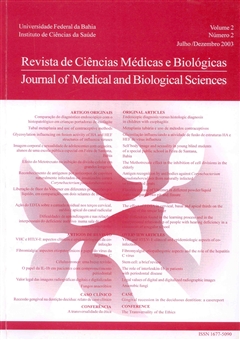The effect of EDTA in cervical, basal and apical thirds on the removal of the smear layer
DOI:
https://doi.org/10.9771/cmbio.v2i2.4288Keywords:
Smear layer, EDTA, Instrumentation.Abstract
On completion of the instrumentation, it is possible to observe sediments of an organic and inorganic material extract of amorphous aspect, with an irregular and granular surface known as smear layer, on the dentine surface. The aim of this study was to analyze, in vitro, the effect of EDTA in 3%, 5%, 10% and 17% concentrations on the removal of the smear layer and cleaning of the dentine tubules through scanning electron microscopy. Eight samples out of 80 teeth were randomly selected to compose the negative control set (GC1) and other 8 units to compose the positive control set (GC2). The remaining 64 composed the 8 experimental sets (GExp). On the instrumentation of the root canal, the final irrigation with the EDTA test solutions was performed. The analysis of the photomicrographs at magnitude 2000X revealed that the apical third showed a lower degree of cleaning than the cervical and basal thirds.Downloads
Download data is not yet available.
Downloads
Published
2003-01-01
How to Cite
Gesteira, M. de F. M., Silva, S. J. A. da, Araújo, R. P. C. de, Lenzi, H., & Rocha, M. C. B. S. da. (2003). The effect of EDTA in cervical, basal and apical thirds on the removal of the smear layer. Journal of Medical and Biological Sciences, 2(2), 208–218. https://doi.org/10.9771/cmbio.v2i2.4288
Issue
Section
ORIGINAL ARTICLES
License
The Journal of Medical and Biological Sciences reserves all copyrights of published works, including translations, allowing, however, their subsequent reproduction as transcription, with proper citation of source, through the Creative Commons license. The periodical has free and free access.


